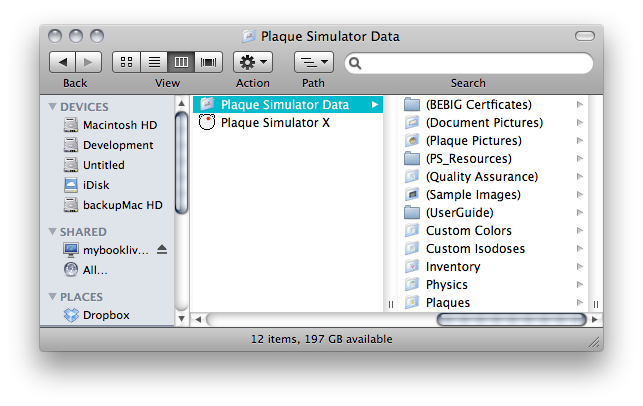|
Plaque Simulator organizes all of its support files in a master folder (aka subdirectory). This folder MUST reside in the same folder as the Plaque Simulator application itself. The default organization of this folder is illustrated below.
When Plaque Simulator is launched it obtains the name of its master data folder from its preferences file. If the preference setting is empty, the default name of "Plaque Simulator Data" is used. While it is NOT recommended, you may permanently or temporarily select another folder to be the master data folder. Using the MacOS Finder, create a new folder in the same folder as the Plaque Simulator application and organize the desired files within it any way you please. Then, relaunch Plaque Simulator, go to the Files & Folders preferences dialog, indicate which folder is to be the new master data folder, click the Save button, and exit the preferences dialog.
|

|
- When Plaque Simulator is launched it recursively scans its master data folder folder, and all folders within it, for recognizable files such as physics, plaques, radionuclide inventory, isodose legends and colors, and builds menus which organize cached links to those files.
- While recursively searching the master data folder for linkable files, Plaque Simulator ignores the contents of folders whose names are enclosed in parentheses (). This provides a way for the program to launch quickly without having to search, for instance, through all the hundreds of user guide files. You can use this mechanism to hide files, such as experimental plaque designs, that you don't want to dispose of, but also don't want to appear in the menus.
- Each menu of linked files also provides an Update option which rescans the master data folder and updates the menu to reflect changes made since Plaque Simulator was launched.
- If inventory (.invy) files are found they are opened (up to a limit of 16) and added to the Select Inventory File menu.
- If plaque (.iplq) files are found (up to a limit of 64) their names are entered into the Plaque Files menu and their filespec is cached for rapid access.
- If isodose (.idos) or color (.iclr) legend files are found (up to a limit of 64) their names are entered into the Isodose Files and Color Files menus and their filespecs are cached for rapid access.
- Likewise, physics files (.iphys) are opened and their data added to the physics resources.
|
